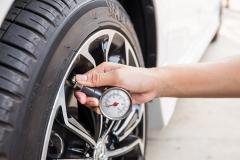
3 minute read
Auto Maintenance & Driving
After a long winter, you're likely ready to give up your hibernating ways for some adventure and sunshine. For many of us this means family vacations, trips to the ballpark, and weekend road trips. Whatever your style, chances are you are getting ready to hit the road, but are you confident that your car is in good enough shape to get you there safely and efficiently?
Winter's weather, cold temperatures, and road salt have been hard on your car, so it is likely showing some signs of wear and tear. Spring is the perfect time to bring your car in for a full inspection to identify any minor problems before they become major ones.
Advertisement
Here are some tips to keep your car running safely this spring and summer:
Check your tires. Check your lighting.
Check all exterior and interior lighting to identify any problems. When your vehicle's lighting is defective, other motorists may not get the message that you intend to stop or turn. The end result could be disastrous.
Check your filters.
Your car has a number of filters that are important to its longevity and should be replaced regularly. Check your engine air filter and your cabin air filter. They're designed to make your engine and you breath healthier.
Change your oil and oil filter.
Changing your oil and oil filter at the intervals recommended in your vehicle's owner's manual is one of the best ways to keep the engine running trouble free. Neglecting to replace engine oil can result in poor engine performance, and even severe engine damage. Replace your wiper blades.

If they're torn or cracked your wiper blades won't do you much good in the middle of unrelenting spring showers when visibility is reduced.
Make vehicle maintenance a priority this spring to protect yourself, enhance fuel economy, and prolong the life of your vehicle!
Check all the fluids under the hood.
Check your power steering, brake, and transmission fluids; your windshield washer fluid; and your coolant. If the levels are low, top them up, and flush/replace them as recommended in your owner's manual. Keep in mind that your power steering, brakes and coolant systems are closed, so low fluid levels may indicate a leak.


Your tires are the only point of contact between you and road, so it's important to take care of them. Check the air pressure of all your tires (including the spare), and maintain the optimal pressure as recommended on the placard on the door jam or in your owner's manual. Check the tread for uneven or irregular wear and for cuts or bruises on the sidewalls and replace them if they are worn or damaged. Check your belts and hoses.

Cold temperatures can harden and/or damage rubber, so it's important to check your belts and hoses for damage. Check your hoses for hardening, softening, leaking, cracks, blistering, or other visual damage, and check your belts for looseness, cracks, frays, or glazing.
Check your battery and charging system.
Cold temperatures can also do a number on your battery, so now is a good time to have it tested and that the connections are clean, tight, and corrosion free. If your battery is more than five years old, you should consider having it replaced before it leaves you stranded.
At CJ's Tire & Automotive, We're Ready When You Are!










